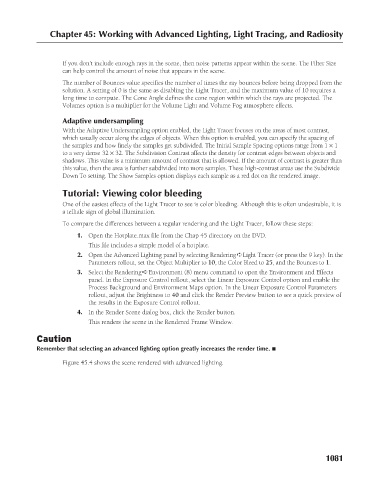Page 1129 - Kitab3DsMax
P. 1129
Chapter 45: Working with Advanced Lighting, Light Tracing, and Radiosity
If you don’t include enough rays in the scene, then noise patterns appear within the scene. The Filter Size
can help control the amount of noise that appears in the scene.
The number of Bounces value specifies the number of times the ray bounces before being dropped from the
solution. A setting of 0 is the same as disabling the Light Tracer, and the maximum value of 10 requires a
long time to compute. The Cone Angle defines the cone region within which the rays are projected. The
Volumes option is a multiplier for the Volume Light and Volume Fog atmosphere effects.
Adaptive undersampling
With the Adaptive Undersampling option enabled, the Light Tracer focuses on the areas of most contrast,
which usually occur along the edges of objects. When this option is enabled, you can specify the spacing of
the samples and how finely the samples get subdivided. The Initial Sample Spacing options range from 1 × 1
to a very dense 32 × 32. The Subdivision Contrast affects the density for contrast edges between objects and
shadows. This value is a minimum amount of contrast that is allowed. If the amount of contrast is greater than
this value, then the area is further subdivided into more samples. These high-contrast areas use the Subdivide
Down To setting. The Show Samples option displays each sample as a red dot on the rendered image.
Tutorial: Viewing color bleeding
One of the easiest effects of the Light Tracer to see is color bleeding. Although this is often undesirable, it is
a telltale sign of global illumination.
To compare the differences between a regular rendering and the Light Tracer, follow these steps:
1. Open the Hotplate.max file from the Chap 45 directory on the DVD.
This file includes a simple model of a hotplate.
2. Open the Advanced Lighting panel by selecting Rendering ➪ Light Tracer (or press the 9 key). In the
Parameters rollout, set the Object Multiplier to 10, the Color Bleed to 25, and the Bounces to 1.
3. Select the Rendering ➪ Environment (8) menu command to open the Environment and Effects
panel. In the Exposure Control rollout, select the Linear Exposure Control option and enable the
Process Background and Environment Maps option. In the Linear Exposure Control Parameters
rollout, adjust the Brightness to 40 and click the Render Preview button to see a quick preview of
the results in the Exposure Control rollout.
4. In the Render Scene dialog box, click the Render button.
This renders the scene in the Rendered Frame Window.
Caution
Remember that selecting an advanced lighting option greatly increases the render time. n
Figure 45.4 shows the scene rendered with advanced lighting.
1081

